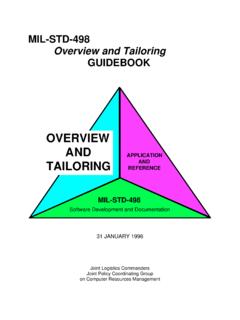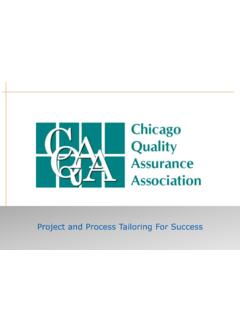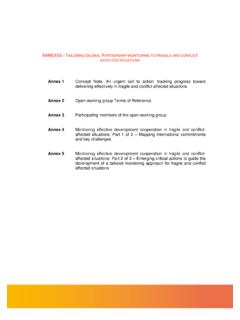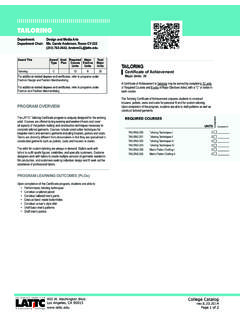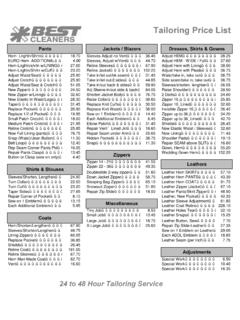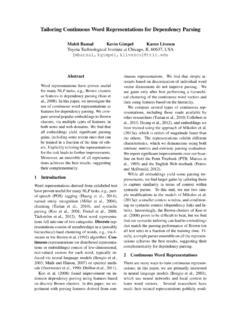Transcription of Tailoring Bank Regulations: Differences in Bank Size ...
1 Tailoring bank regulations : Differences in bank Size, Activities, and Capital Levels David W. Perkins Analyst in Macroeconomic Policy December 21, 2017 Congressional Research Service 7-5700 R45051 Tailoring bank regulations : Differences in bank Size, Activities, and Capital Levels Congressional Research Service Summary Banking organizations differ across a multitude of characteristics. The amount of assets they hold, the services they provide, and how they secure funding are just a few examples. These Differences affect an individual organization s risk of failure and the risk its failure or distress could pose to the overall financial system. Policymakers generally agree that certain banking regulations should be tailored to account for such Differences , and as a result, banks are currently subject to or exempt from various regulations if they meet certain criteria.
2 To what degree existing bank classifications adequately tailor regulation and how Tailoring should be designed and implemented are debated issues. This report examines existing and proposed bank regulatory classifications, legislation that proposes to change existing classifications or create new ones, and, the characteristics of bank organizations that fall under existing and proposed classifications. Banks are classified in a variety of ways. Some are informal classifications that refer to widely understood Differences between community and Wall Street banks two commonly recognized types of banks but that are unofficial classifications that do not affect banking regulations . For example, community banks are understood to be small institutions that meet the credit needs of a community and Wall Street banks are understood to be large, complex institutions that could individually pose risk to the financial system.
3 Existing regulatory classifications are official classifications applied to banks that meet some criteria and determine whether a bank is subject to certain regulations . In addition, several existing proposals would establish new regulatory classifications and criteria. Often (but not always) existing criteria are size-based thresholds that subject a bank to more stringent regulation once it exceeds a certain amount of assets. Proponents of this system argue simple, bright line rules create certainty and transparency and that asset size is an adequate measurement to identify which institutions should or should not be subject to certain regulation. Critics argue it too narrowly focuses on one aspect of a bank organization, and thus may subject certain banks to inappropriate regulation. Critics may argue that new or additional criteria based on other characteristics ( , the business activities a bank engages in or the amount of capital it holds) should be implemented.
4 To investigate how well certain criteria would appropriately tailor regulation, it is informative to examine characteristics of banking organizations and compare banks that meet some criteria to those that do not. This report examines characteristics such as asset size; concentrations in loans, deposits, trading assets, and trading liabilities; activity in derivatives; and capital levels. The analysis generally suggests that these characteristics are correlated; larger banks tend to be involved in more business lines and hold less capital whereas smaller banks tend to be more focused on making loans and taking deposits and hold more capital. However, the large number of banks and the high degree of variation across multiple variables means that no set of criteria is easily and objectively identifiable as the best means of Tailoring regulations . In the 115th Congress, numerous bills including 10, 1116, 1948, 2121, 3072, 3312, S.
5 1002, S. 1284, S. 1499, and S. 1893 would change the existing system of bank regulation Tailoring . Some would alter existing size-based classifications or introduce new sized-based criteria, and others would establish new activities-based or capital-based criteria. Tailoring bank regulations : Differences in bank Size, Activities, and Capital Levels Congressional Research Service Contents Introduction .. 1 Classifications of Banks .. 2 Unofficial Classifications .. 2 Main Street .. 3 Wall Street .. 4 Somewhere In Between .. 4 Selected Official Classifications and Exemption Thresholds .. 5 $1 Billion Threshold .. 5 $10 Billion Threshold .. 6 $50 Billion Threshold .. 7 Advanced Approaches Banks .. 7 Globally Systemically Important Banks .. 8 Selected Proposals for Additional Tailoring .. 9 Activities-Based Criteria .. 10 Capital-Based Criteria .. 11 Regulator Tailoring with Required Analysis.
6 13 bank Characteristics .. 14 Banks by Asset Size .. 14 Characteristics Across Different Asset Sizes .. 15 Differences Between Banks: Existing Size-Based Classifications .. 17 Size Trends .. 18 Banks by Activities .. 19 Industry Activities Statistics .. 19 Differences Between Banks: Approximate TBO Criteria .. 21 Banks by Capital Levels .. 22 Industry Capital Level Statistics .. 22 Differences Between Banks: 10% Tier 1 Leverage Ratio Threshold .. 23 Selected Legislation .. 24 New or Changed Asset-Size Thresholds .. 24 Activities-Based Proposals .. 25 Capital-Based Proposals .. 25 Regulator Designations and Tailoring .. 26 Conclusion .. 26 Figures Figure 1. Loan and Deposit Concentrations Across Size Cohorts .. 17 Figure 2. Trading Asset and Liability Concentrations Across Size Cohorts .. 17 Tables Table 1. Number of BHCs Meeting Selected Classification Groups .. 9 Table 2.
7 Size and Selected Activities of the 20 Largest Banking Organizations .. 15 Table 3. BHCs Over $1 Billion: Averages by Selected Classifications .. 17 Tailoring bank regulations : Differences in bank Size, Activities, and Capital Levels Congressional Research Service Table 4. BHCs Over $1 Billion: Trading Versus No Trading .. 20 Table 5. BHCs Over $1 Billion: Averages by Derivative Activity .. 20 Table 6. BHCs Over $1 Billion: TBOs Versus Non-TBOs .. 21 Table 7. BHCs Over $1 Billion: Averages by Tier 1 Leverage Ratios .. 23 Table 8. BHCs Over $1 Billion: Averages Above, Near, Below a 10% Leverage Ratios .. 24 Table A-1. Metrics Used in Analysis of Banks .. 27 Table of Groupings .. 27 Appendixes Appendix A. Variable and Grouping Descriptions .. 27 Appendix B. Traditional Banking Organization Criteria and Leverage Ratios Compared .. 28 Contacts Author Contact Information.
8 29 Tailoring bank regulations : Differences in bank Size, Activities, and Capital Levels Congressional Research Service 1 Introduction Banks differ from each other across numerous aspects of their business models, including balance sheet size, breadth of products and services offered, funding sources, and risk appetite, among Policymakers and experts generally agree that bank regulation should be tailored to account for these Differences between As result, regulations are generally applied to banks based on meeting or not meeting some criteria. These criteria are established on an ad hoc basis, and are often (but not always) based on whether the bank is above or below a certain asset size threshold, such as $1 billion, $10 billion, or $50 billion in total assets. To what degree the application of regulation should vary and how those variations should be designed and implemented are debated issues.
9 These issues have been prominent in recent years at least in part because legislative and regulatory responses to the financial crisis such as the Dodd-Frank Wall Street Reform and Consumer Protection Act (Dodd-Frank; 111-203) and the international agreement known as Basel III Accord3 have amended or introduced a number of regulations that include Tailoring criteria. bank regulation aims to achieve certain potential benefits ( , better-managed risks, increased consumer protection, greater systemic stability) that justify potential costs of the regulation ( , reduced credit availability for certain consumers and businesses, slower economic growth over some period of time).4 The size of the realized benefits and costs of a regulation for any individual bank or group of banks are likely to depend in part on certain characteristics of that bank or group, such as willingness to take on risk, systemic importance, and ability to absorb compliance costs.
10 Thus, appropriately fitting regulation to banks of different types is an important component of designing effective and efficient regulation. For illustrative purposes, consider the following simplified example. A regulation aimed at reducing systemic risk may produce greater benefit when applied to a very large, complex, globally active and interconnected institution than when applied to a single-branch institution making residential and farm loans in a rural community. In addition, the large institution may have more resources to comply with the regulation. 1 In general, this report uses the term bank interchangeably to refer to Federal Deposit Insurance Cooperation (FDIC) -insured depository institutions (IDIs) or organizations that own one or more IDIs, including bank holding companies (BHCs), financial holding companies, intermediate holding companies, and savings and loan holding companies.










